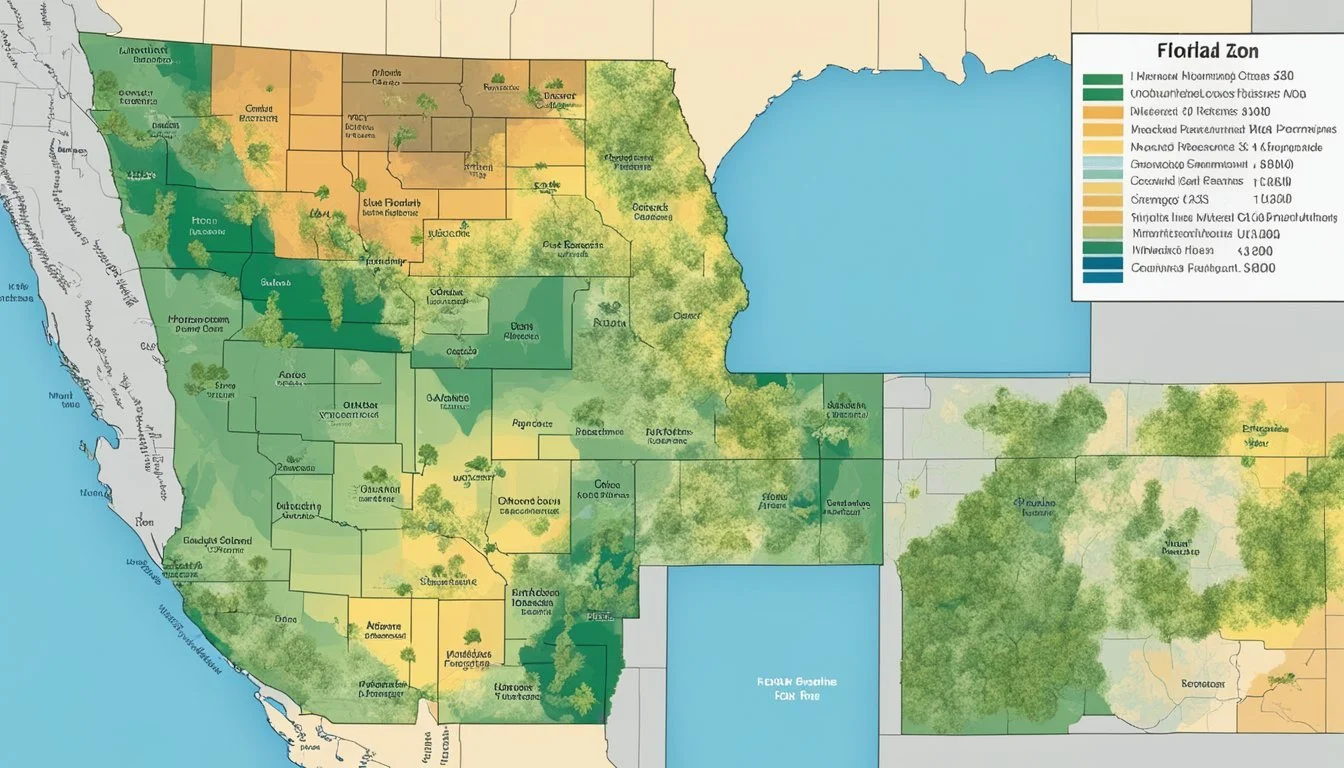USDA Hardiness Zones in Florida
A Guide to Planting and Gardening
Understanding the USDA Hardiness Zones is crucial for gardeners and horticulturists in Florida. These zones are defined by the United States Department of Agriculture and provide a standard by which plant appropriateness for a location can be determined. Derived from the average annual extreme minimum winter temperature over a 30-year period, the plant hardiness zone map is an essential tool for predicting which plants are most likely to thrive in a particular area.
The USDA Plant Hardiness Zone Map designates areas into 10-degree F zones and 5-degree F half zones to reflect the varying climatic conditions across the country. In Florida, a state characterized by its warm climate and long growing season, these zones are particularly important. Due to the state's geography — stretching from temperate in the north to tropical in the south — the plant hardiness zones range considerably, affecting both native flora and garden plant selections.
Florida's zones, as delineated on the USDA Plant Hardiness Zone Map, show how the state is partitioned into discrete climatic zones. This influences not only the types of plants that will flourish but also the timing of planting and the care required for plants throughout the state. Consequently, understanding these zones is crucial for successful gardening and agricultural planning in Florida.
Understanding USDA Plant Hardiness Zones
The USDA Plant Hardiness Zone Map is a critical tool for growers and gardeners to determine the potential success of perennial plants in their area, focusing specifically on minimum winter temperatures.
The Basics of Plant Hardiness Zones
Plant hardiness zones are areas defined by the United States Department of Agriculture based on the average annual extreme minimum temperature. These zones are essential for agriculture and horticulture, guiding the selection of crops and plants that are most likely to thrive in a location. The zones range throughout the national landscape, assigning a number and letter (for example, 8a or 9b) to each region.
The Role of USDA in Defining Zones
The USDA's role in defining hardiness zones is to provide a standard by which gardeners and growers across the United States can work effectively with their local climate. They compile climate data and publish updates to the zone map to reflect changes such as those resulting from climate patterns. This service is a fundamental resource in United States agriculture, ensuring that decisions made are informed by the most current and accurate temperature data available.
Interpreting the USDA Plant Hardiness Zone Map
Interpreting the map requires an understanding of its presentation of temperature ranges. It is divided into zones that represent 10-degree F temperature bands which are further subdivided into 5-degree F increments. For example, a zone labeled '9a' indicates the region has average annual extreme minimum temperatures between 20°F and 25°F. This information allows for decisions about planting to be made with confidence, taking into account the suitability of specific plants for the temperature profile of each zone in Florida and beyond.
Florida's Climate and Its Impact on Gardening
Florida's diverse climate significantly influences gardening strategies across the state. Gardeners must consider regional climate variations, temperature-related growing seasons, and the effects of climate change on USDA Hardiness Zones to ensure successful horticulture.
Regional Climate Variations in Florida
Florida exhibits a wide range of climatic conditions, from the cooler, wetter Panhandle to the warm, tropical settings of the Keys. Northern areas, including Tallahassee, experience cooler temperatures, while Miami's southern location maintains a notably warmer climate year-round. These variations result in distinct microclimates that affect what can be grown successfully in each region.
Temperature and Growing Seasons
The state's temperatures guide planting schedules, with Hardiness Zones ranging from 8a in the northwest to 11b in the southern tip. The coastal regions, influenced by maritime weather patterns, tend to have more moderate temperatures that extend the growing season. Conversely, areas farther inland may encounter cooler temperatures and occasional frost, which impacts planting timelines for various crops.
Impact of Climate Change on Florida's Hardiness Zones
Climate change is reshaping Florida's Hardiness Zones, as warmer temperatures push these zones northward. This shift affects both native and non-native plant species, challenging growers to adapt their practices. Increased humidity and extreme weather events, including a reduction in incidences of snow in the northern regions, encourage gardeners to reassess their selections of plant species to maintain productive gardens.
Detailed Guide to Florida's Hardiness Zones
Florida's Hardiness Zones range from 8 in the north to 11 in the Keys, impacting local planting strategies significantly. Knowledge of these zones helps gardeners determine which plants are most likely to thrive.
Zones in North Florida and the Panhandle
In the Panhandle and North Florida, zones 8a to 9a predominate. These areas experience cooler temperatures than the rest of the state, affecting planting times and plant hardiness. Cities like Pensacola fall within zone 8b where the temperatures can drop to 15°F to 20°F. It's essential for gardeners to consider their local zip code when selecting plants, as microclimates can cause subzone variations.
Central Florida's Growing Zones
Central Florida is characterized by zones 9b to 10a. The region's mild winters allow for a broad range of plants to be grown. Cities such as Orlando are classified within zone 9b, meaning gardeners in this area can expect minimum temperatures of 25°F to 30°F. Knowing the specific zone for one's locale is crucial for successful planting and gardening.
South Florida and the Keys' Unique Conditions
South Florida and the Keys are in zones 10b to 11, where the climate is tropical and frost is rare. This region includes cities like Miami in zone 10b and the Florida Keys in zone 11, where the temperature rarely drops below 40°F. Such conditions mean planting can often occur year-round, and tropical plants that cannot survive farther north flourish here.
For more information on planting strategies specific to each zone, gardeners should refer to resources like the USDA Plant Hardiness Zone Map or seek local advice taking into account the unique climate concerns of their regions.
Selecting Plants for Your Florida Garden
When planning a garden in Florida, it's crucial to consider the state's unique climate zones and native flora. The success of a garden largely depends on choosing plants that are well-suited to the area's growing conditions.
Using the Hardiness Zone Map for Plant Selection
The USDA Plant Hardiness Zone Map is an essential tool for gardeners in Florida. It guides them in choosing plants that can thrive in their specific location. For example, zones in Florida range from 8a to 11b, each indicating the plant's ability to withstand the average annual minimum temperatures. Knowing your zone allows you to select perennial plants that are most likely to survive year after year.
Florida-Friendly Landscaping™ and Native Plants
Implementing Florida-Friendly Landscaping™ practices means choosing plants that are adaptive and less taxing on the environment. Native plants play a significant role in this type of landscaping because they are already adapted to the local climate and soil conditions. Florida gardeners are encouraged to consult with a master gardener or utilize resources from the Florida-Friendly Landscaping™ Program to create a resilient and water-wise garden.
Tips for Florida Gardeners
Gardeners in Florida should consider the following when selecting plants:
Research: Understanding the nuances of Florida's growing zones is vital. Each garden and location within the state may have different microclimates affecting plant growth.
Consultation: Seek advice from local nurseries or county extension offices, as they often have master gardeners on hand.
Plant Selection: Always opt for plants suited to Florida's climate, such as those listed on the Florida-Friendly recommended plants page.
Observation: Track seasonal temperature changes as they could affect the plant hardiness, especially with shifting climate patterns.
By considering these factors and utilizing the available resources, Florida gardeners can ensure a thriving and sustainable garden that complements the state's diverse ecology.
Tools and Resources for Florida Gardeners
For Florida gardeners looking to make the most informed decisions about what to plant, there is a wealth of resources at their fingertips. These include interactive digital tools, educational materials crafted by university experts, and local extension services equipped to provide guidance tailored to Florida's unique climate.
Interactive Maps and Tools
Florida gardeners have access to various interactive maps and tools which integrate data from weather stations and geographic information systems. One particularly helpful resource is the Florida Interactive USDA Plant Hardiness Zone Map by Plantmaps. This tool allows users to pinpoint their exact gardening zone by entering their ZIP code. It provides crucial information about the lowest temperatures one can expect, which is important when selecting plants for the garden.
UF/IFAS Extension and Gardening Resources
The UF/IFAS Extension is an invaluable resource, offering Gardening Resources that are research-based and Florida-specific. The University of Florida's Institute of Food and Agricultural Sciences provides not only advice but workshops and events for all levels of gardeners. The Florida-Friendly Landscaping™ Program, for example, provides guidelines and services aimed at conservation and sustainability within home landscapes.
Educational Materials and eBooks
Florida gardeners can enhance their knowledge through an array of educational materials and eBooks. These often include works published by the University of Florida as well as other institutions, such as Oregon State University. Resources covering a broad range of topics from plant care to landscaping design are available, including an interactive guide to understanding the USDA hardiness zones, and eBooks that can be downloaded for in-depth reading on various horticultural subjects.
Advancements in Hardiness Zone Research
Recent studies by USDA's Agricultural Research Service have provided significant insights, updating our understanding of hardiness zones—a key component in predicting plant survival and agricultural planning.
USDA's Agricultural Research Service Contributions
The USDA's Agricultural Research Service (ARS) plays a critical role in mapping plant hardiness zones. In 2023, ARS released an updated Plant Hardiness Zone Map, reflecting shifts in climate patterns. The new map serves as a pivotal tool for gardeners, growers, and researchers, layered into research models to track invasive species and provide detailed information on regions' suitability for different plant species.
Studying the Effects of Global Climate Change
Global climate change is a driving factor behind the USDA's updates to the hardiness zones. The ARS diligently monitors the average annual extreme minimum winter temperatures, adapting the map to climatic fluctuations. These temperature-based zones are crucial in determining which perennial plants are most likely to thrive, directly impacting the survival of plants and the broader sphere of agriculture.
The Future of Hardiness Zones and Agriculture
Looking ahead, the advancement in hardiness zone research is set to shape the future of agriculture. With continued updates expected as part of the ARS's ongoing efforts, these maps will aid agriculturalists in making informed decisions. Adapting to climate change and ensuring the success of crops across different zones remains a primary goal for the ARS, underpinning the survival of plants and the resilience of agricultural ecosystems.
Understanding Half-Zones and Microclimates
Understanding the variations within USDA Hardiness Zones, specifically the half-zones and the presence of microclimates, is critical for successful gardening and agriculture in Florida. These variations can significantly influence plant survival and performance.
The Significance of Half-Zones
The USDA Hardiness Zone Map categorizes regions based on the average annual extreme minimum temperature. In Florida, these zones are indicated as 10-degree Fahrenheit zones and are further refined into 5-degree Fahrenheit half-zones labeled as "a" or "b". For example, zone 9 can be divided into 9a and 9b, with 9a being the cooler half. These half-zones represent more precise conditions that gardeners can use to determine which plants are best suited for their specific location.
Zone 9a: lowest temperatures of 20°F to 25°F
Zone 9b: lowest temperatures of 25°F to 30°F
Half-zones are a way to acknowledge that even within the same geographical area, the climate can vary enough to impact the survival and growth patterns of certain plants. By identifying their half-zone, Florida gardeners can make informed decisions on plant selection, ensuring a more resilient landscape.
Microclimates Within Florida
Florida's diverse topography can create a variety of microclimates that can differ significantly from the general climate of the region. Factors such as proximity to bodies of water, urban areas, elevation changes, and specific landforms can influence the local climate within small geographic areas, often resulting in marked fluctuations in temperature and humidity.
For instance, an urban area might retain more heat due to infrastructure, thus being warmer than surrounding rural areas. Conversely, low-lying spots in close proximity to water may experience cooler temperatures, creating pockets where frost-sensitive plants might be at greater risk.
It is vital to recognize these microclimates when planning planting and cultivation, as they can influence the success of local horticulture to a greater extent than the broader zone designations might suggest. Gardeners should observe their immediate surroundings to assess whether these microclimate factors could warrant extra considerations beyond the half-zone designations.
Hardiness Zones Beyond Florida
In exploring hardiness zones beyond the borders of Florida, one will find a range of climates in other states and U.S. territories that significantly affect plant growth and sustainability. Different regions have unique minimum temperatures that determine their respective classifications.
Hardiness Zones in Hawaii and Puerto Rico
Hawaii's climate varies drastically across its islands, encompassing USDA zones from 9 to 13, with the lowest temperatures ranging typically from 20°F to 60°F. This diversity allows for a vast array of plants, from tropical to temperate, to thrive throughout the islands. Puerto Rico, predominantly within zones 11 to 13, maintains a tropical climate conducive to a rich diversity of plant life which displays the island's consistent warm temperatures year-round.
Comparing Florida's Zones With Other Regions
Florida's Zones:
Northern parts: Mostly 8b to 9a
Central regions: Primarily 9b
Coastal areas: Generally 10a
Regional Differences:
Northeast US: Zones can range from 3 to 7
Midwest US: Predominantly 4 to 6
Southwest US: Typically 6 to 10, with arid areas
In contrast, Florida exhibits a mixture of tropical and subtropical climates across its territories. The Northeast US is known for colder winters, making it suitable for temperate plants that can withstand freezing temperatures. The Midwest shares similar cold hardiness zones but can have warmer sections pushing into zone 6. Meanwhile, the Southwest has hot and arid zones, thus revealing the broad spectrum of climates and hardiness zones present beyond Florida.
Frequently Asked Questions
The USDA Hardiness Zones are crucial for gardeners and growers in Florida to understand which plants can thrive in their specific locale. These zones are determined by the average annual extreme minimum temperatures.
What are the predominant USDA Hardiness Zones found in Florida?
Florida predominantly falls into USDA Zones 8, 9, 10, and 11, with differences in temperature shaping each zone's plant viability.
How can I determine the USDA planting zone for my specific location in Florida by zip code?
To determine the precise USDA planting zone for a specific location in Florida by zip code, individuals can refer to the USDA Plant Hardiness Zone Interactive Map, which offers detailed information based on zip code inputs.
Which plants are suitable for growth in USDA Zone 10?
USDA Zone 10 supports a wide range of tropical and subtropical plants due to its warm climate, some of which include hibiscus, bougainvillea, citrus trees, and various palms.
What is the USDA Hardiness Zone for Orlando, Florida?
Orlando, Florida is in USDA Hardiness Zone 9b, tailored to plants that can withstand a minimum temperature of 25°F to 30°F.
How do USDA zones in Florida correspond to specific climate conditions for gardening?
USDA zones in Florida correspond to climate conditions that vary from colder temperatures supporting temperate plants in the north (Zone 8) to tropical conditions in the south (Zone 11), each influencing the plant selection for gardening.
In which USDA Hardiness Zone is St. Augustine, Florida categorized?
St. Augustine, Florida is categorized within USDA Hardiness Zone 9a, indicating it has average annual extreme minimum temperatures of 20°F to 25°F.







